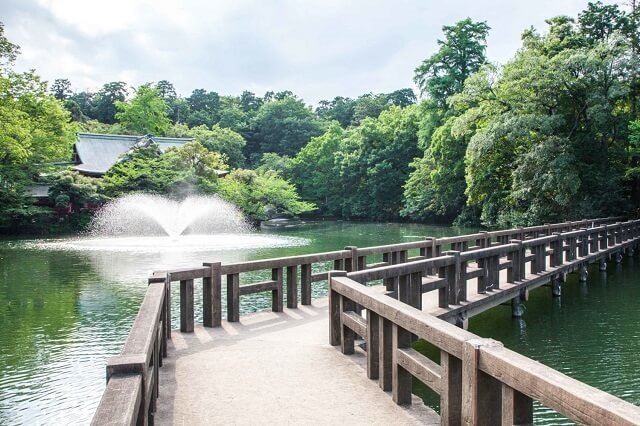
Inokashira Park has always been an important place for Tokyoites. Located west of the city’s center on the JR Chuo Line, it is a source of art, culture and, crucially, water.
-
![Inogashira Park]()
Inogashira Park
The park is reputed to have gotten its name, which literally means wellspring or well head, from the 3rd shogun, Tokugawa Iemitsu (grandson of Tokugawa Ieyasu), who chose Edo as his capital in 1590. Ieyasu himself is said to have used water from the spring called Ochanomizu (tea water) on the pond’s western edge for his tea ceremony, and waters from this area formed the man-made Kanda water supply, which fed Edo for more than two centuries until more modern supply systems were completed in 1898.
![Inogashira Park]()
Inogashira Park
![]()
In 2017 Inokashira Park will celebrate the centenary of being given to the people as a gift from Emperor Taisho in 1917. The park is worth visiting for several reasons. Amid tall trees and wandering paths a sizeable pond, home to large koi (carp), ducks and other forms of life, is the defining feature, and small rowboats and paddle boats can be rented to set out upon it. But be warned: There is an oft-repeated saying in Japanese to the effect that couples who venture forth in boats at this park will surely break up soon.
This green space is also famous for hanami, or the viewing of plum and cherry blossoms in spring, when it absolutely teems with visitors. But forget about the boats and the blossoms, and set the park’s modest zoo aside. The real appeal of Inokashira lies in its lesser-known gems.![Inogashira Park]()
Inogashira Park
The first of these is the Inokashira Park Art Mart, a glorious and motley collection of artists that congregate along the paths each weekend, rain or shine, to display (and often sell) their myriad talents.
![Inogashira Park]()
Inogashira Park
![]()
![]()
The work of the quieter ones speaks for itself and includes crafts, jewelry such as necklaces and beadwork, paintings, portraits and much more, though not every visual artist is there to sell.
But there is busking as well, live shows of magic and other physical feats. Of particular note is a fellow named Rikimaru Toho, a kind of verbal animator who for a small fee will read large-print manga comics aloud in a host of voices.![Inogashira Park]()
Inogashira Park
-
![Inogashira Park]()
Inogashira Park
![]()
Also worth looking out for, though by no means hard to spot, is Broom Duster Kan, an elderly chap who sings rockabilly, rhythm and blues and just plain blues while self-accompanying simultaneously on steel guitar and sometimes harmonica. He wears a portable speaker on his hip, strides around as he plays and otherwise gives the impression that he’s the soul of the park.
![Inogashira Park]()
Inogashira Park
For those on their way to the fantastic Ghibli Museum, rather than exiting at Mitaka Station, try getting off at Kichijoji Station and walking through to the park’s southwestern corner, where this wonderland of animation can be found. Visitors take note – tickets are needed, often bought as in advance as possible, owing to the ubiquitous popularity of this studio’s characters and films.
![Inogashira Park]()
Inogashira Park
The second of Inokashira’s subtle draws is the presence of a few excellent shops so dug in as to be nearly inconspicuous. Pepa Cafe Forest is the most visible, set a bit into the trees on the southern shore of the pond. It does Thai and fusion cuisine, sells a few beers and has a patio that affords generous elbow room.
![Inogashira Park]()
Inogashira Park
![]()
Off the western shore is Café du Lièvre, a hare-themed cozy little space that serves galettes (buckwheat crepes, both meals and deserts), soups, drinks, and other French fare.
![Inogashira Park]()
Inogashira Park
![]()
-
Though slightly harder to find, an apparently nameless and rather ramshackle shop that manages to stand among the trees is a source of truly high-grade coffee that’s freshly made and ground, and topped with the “latte art” sometimes seen in social media photos. This excellent little shack has become quite popular among parkgoers, and as the coffee is take-out only, many people stop by for a cup to enrich their stroll. There are other shops too, meaning thorough exploration will be rewarded.
Another of Inokashira’s salient features is a shrine for the Buddhist goddess Benzaiten, who is Indian in origin but also recognized by Japan’s native Shinto religion. Benzaiten is the gestalt of Inokashira personified, or rather deified: She is the patroness of rivers and water, language and knowledge, wealth and good fortune, as well as music and poetry, among others.![Inogashira Park]()
Inogashira Park
![]()
![]()
The small shrine grounds are even home to the grindstone Tokugawa Ieyasu used to make his tea, and if you stand just before the bridge, you can still see a fading likeness to the scene that famed woodblock artist Utagawa Hiroshige did of the site back in 1845.
Access: Five-minute walk from Kichijoji Station on the JR Chuo and Keio-Inokashira lines, or a one-minute walk from Inokashira-koen Station on the Inokashira Line.- ペパカフェ・フォレスト
-
-
- 東京都三鷹市井の頭4-1-5 井の頭恩寵公園
-
-
-
- 0422-42-7081
-
View All
- Cafe du liever うさぎ館
-
-
- 東京都武蔵野市御殿山1-19-43
-
-
-
- 0422430015
-
View All
Kichijoji Tokyu REI Hotel
1-6-3 Kichijoji Minami, Musashino Tokyo





















 Go here
Go here










